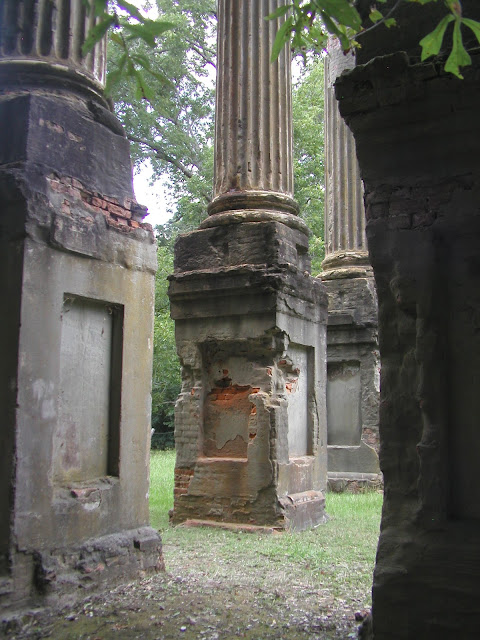 |
| Windsor Ruins near Port Gibson, MS Photo by Elodie Pritchart |
One hundred years ago, a distinguished New Englander made the entire trip to Natchez by boat, and the beauty of the country seemed to strike him with particular force. He wrote a fascinating record of his impressions and among other things said:
The town, Natchez, is mantled with a rich, green foliage, like a garment. A noble esplanade runs parallel with the river; at the northern extremity of this esplanade, upon an eminence, gradually yet roundly swelling away, stands Clifton. Its lofty colonnades glance in the sun, and a magnificent garden spreads out around it. This garden is diversified with avenues and terraces, and adorned with grottoes and summer-houses.
Clifton was old when the the Civil War began. It was built for Samuel Postlethwaite, about 1820. Later, Mr. Frank Surget owned it. His wife was Mrs. Charlotte Linton, who was wealthy in her own right. Clifton was her ancestral home, built by her parents.
The grounds were landscaped by European artists, and exotic plants rioted in a cloud of fragrant bloom. A commanding view of the Mississippi River and the fertile plains of Louisiana lent peculiar picturesqueness to the entire setting.
Such was the fairylike Clifton when, at the close of that historic siege, Vicksburg fell. Natchez was then placed under military rule with six hundred Union soldiers garrisoned there. Mr. Surget invited a number of these officers to dine at Clifton but, by some oversight, failed to ask the chief engineer. In speaking of the matter later, Mr. Surget said:
"It was not an intentional slight on my part."
The next day, a peremptory order came to the Surgets to vacate their house. The order said that it was necessary to erect fortifications where Clifton stood.
It seemed strange to Mr. Surget that no other site could be found. "Natchez is a fallen city!" he expostulated. "There is no reason to fortify the place!" But the chief engineer was obdurate.
In their astonishment and excitement, the Surgets only found time to gather up the family silver and a few personal belongings before Clifton was blown to atoms. The detonation of the explosion was heard for miles; not one brick was left upon another. Even the gardens were demolished; the greenhouses, grottoes and pavilions were leveled to a mass of debris.
The loss of their beloved house, treasures and keepsakes weighed heavily upon the hearts of these gentlefolk, and as soon as peace was declared they prepared to depart for France to make their home. But Mr. Surget did not live long; he died in America before they could sail, though his wife continued living in Bordeaux to a ripe old age.
War is always hideous, and Natchez fared better than most Southern Cities. The memory of Clifton has faded, though a section of Natchez perpetuates the name of the beautiful house that was wantonly sacrificed to one man's petty animosity.
The inhabitants of Natchez today, these descendants of that gallant band who enjoyed the spacious life of the feudal days of Southern civilization, have little inclination to indulge in unhappy retrospection. They love beauty, and it is around them in abundance. The pink, white and cerise azalea, the japonica, the sweet olive and the cape jasmine are ever before them, tiny monuments to the beauty of a civilization that has died.
Needless to say, times have changed and the "feudal days of Southern civilization" are no longer referred to in such glowing terms. One cannot dismiss, however, the beauty of the architecture that those "feudal days" made possible. I love my little town unabashedly and am proud to call it home as it struggles (at times more successfully and at times less so) to acknowledge the realities of the past and embrace a future where one and all live in harmony.
An interesting footnote:
In 1900, my great grandfather built a house on the bluff where Clifton had once stood. Back around 1982, I was at the house visiting my great aunt, Annet Pritchartt. We were standing in the driveway when my husband looked down at the ground and suddenly exclaimed, "Wow. Is that a Civil War bullet?" He leaned down and plucked it up. It was, indeed, a Civil War bullet. Perhaps a relic of that fateful day at Clifton.
Wow! Thanks for posting this.
ReplyDeleteThanks for this post. Beautiful and so interesting. There's a painting by Audubon of Natchez 1823 and shows Clifton. Here's a link to the painting in Antiques Magazine APRIL 30, 2018 http://www.themagazineantiques.com/article/breaking-new-ground/ Clifton is to the far left; the last structure there.
ReplyDeleteI have been struck by the story of the senseless destruction of Clifton ever since I read of it in Harnett Kane's "Natchez on the Mississippi", as well as Stark Young's novel "So Red the Rose." Do you know of any paintings or floor plans relating to the mansion, or detailed descriptions of the gardens? I'd like to get a more precise image of what this showplace looked like.
ReplyDeleteMr. DiMaggio, I don't. If there are any, though, the Historic Natchez Foundation would know. Their phone number is (601) 442-2500. Good luck, and let me know if you find anything. Tell them Elodie told you to call.
Delete